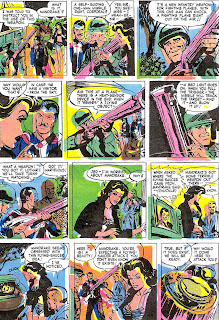"Fangs of the Panther," from Harvey's All-New Comics #11, which is cover-dated Spring 1945, is probably at least partially inspired by the movie, Cat People, which was a big hit in 1942. Jerry Robinson, who had started his career assisting Bob Kane on Batman, is the artist. He was proud of this story, or appeared to be, since he signed it in both the splash and last panels. Signed comic book stories weren't unusual, but signed in two places was unusual.
Robinson died December 8, 2011, at age 89. He was active at that late stage in his life, based on this drawing of Robinson which appeared in The New Yorker magazine in May, 2011. Robinson was one of the pioneers of comic books, having joined Kane's studio as a teenager in those days when comics were finding their form.
Another pioneer, Bob Powell, was also represented in the same issue of All-New Comics, with a predecessor to the character, The Man in Black Called Fate*, the Man in Black Called Death, a name with a morbid air about it. It's the same character, though, with the gimmick of the Fate/Death character's face always in shadow.
*The Man in Black Called Fate is represented here by issues number 1 and 2 from 1957 in Pappy's #822, and Pappy's #1019. In 1947 the character appeared in Green Hornet Comics as The Man in Black, who introduced himself as Mr. Twilight! I showed a story in Pappy's #867.
























































































